Have you ever wondered what pickups are in your guitar if you bought it on a second-hand market? If you are sure they are not original, they came with a guitar. It can be done.
So, How To Identify The Pickups In Your Guitar? Firstly you can identify them by looks; there are 3 most common pickup variations on the market. There are single-coil, humbucker, and P-90 pickups. If you want to identify the exact model or manufacturer of the pickup, in most cases, you’ll have to unscrew them from the guitar.
There are a few more things that set them apart from each other. Today there are quite a lot of companies making them, and a huge variety of models. So we will cover all things related in this article. Keep on reading, and you’ll learn everything you need to know about identifying different pickups.
How Can You Identify Them By Looks?

As mentioned, there are three main pickup types, and their look is pretty distinctive. It is very easy to spot which is which the moment you see them.
Single coil pickups
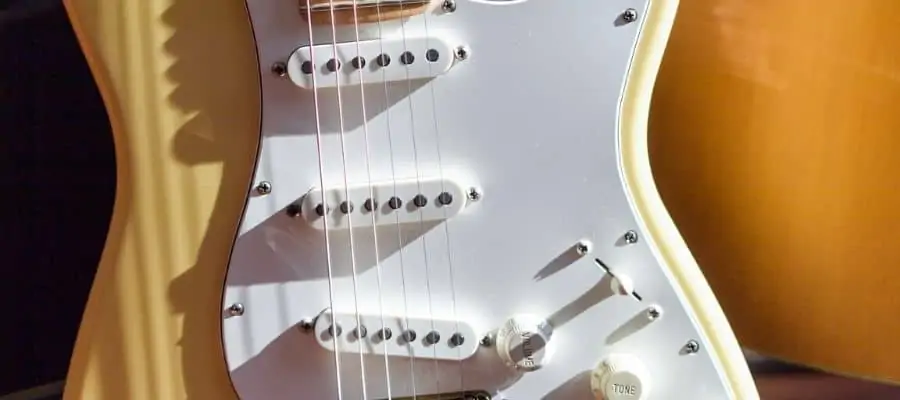
Single-coil pickups are characterized by their thin and small shape. Typically their magnet poles are visible on their surface as small metallic dots. But there are also ones that look like a thin plastic or metal bar. They are usually half an inch or a couple of centimeters thick. They are often screwed into the guitar’s body on the top and bottom with two screws.
Humbucker pickups
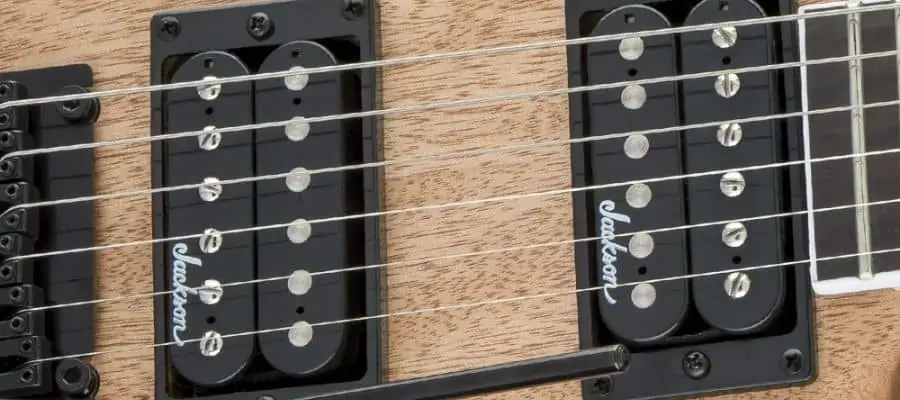
Humbuckers are larger and wider compared to single-coil pickups. They are often twice the size of single coils and feature 3 screws to hold them attached to the guitar’s body. They have different versions but most look like two single-coil pickups attached.
Depending on the model, other humbucker types look like wide pickups with a metal or plastic housing. They can even come in single-coil shape for guitars that do not have enough pickup space for a humbucker.
P90 pickups
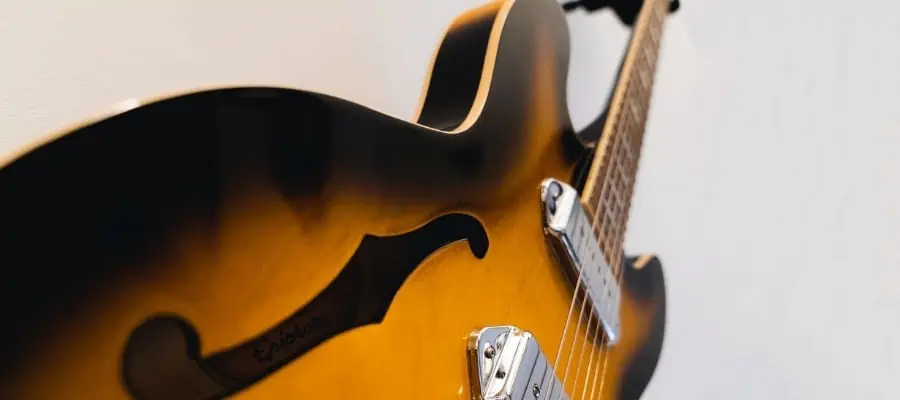
P90 pickups are vintage-style pickups that resemble single-coil pickups but are a bit wider. They typically measure around an inch or 2.5 centimeters. They are usually held down by two screws between the magnet poles.
They can be in a humbucker size. So, they would fit in the humbucker cavity, like, for example, a Gibson Les Paul. But again, those are specialty pickups that some companies produce but are rare.
A few more pickup types are not that common, such as Filler-Tron pickups, od Jazzmaster, and Jaguar pickups on Fender guitars.
How Can You Identify Them By Sound?

While often it is quite easy to identify pickups by their looks, sometimes there are cases that you can not be sure about. So for these situations, you will have to trust your ears. It is not easy to differentiate pickup styles by their sound, but you can get a hint by playing clean tones. If the sound is thin, bright, and twangy, often it is a single-coil pickup.
On the other side, humbucker pickups provide a more bassy response that sounds fuller, warmer, and sometimes punchy. The sound may get muddy from time to time.
The P90 pickups sit in the realm between the two worlds and are hardest to differentiate. They have the bass response of humbucker, but they do not go as muddy as them.
But this is not a certain method, and you must train your ear to hear the differences.
You can also try setting your amp to a high-gain tone and listening to the responses of your pickups. If you have humbucker, they will be quiet, punchy, and focus sounding. The single-coil will have that 60s cycle hum, they will sound unpleasant, and you won’t be able to hear articulation in the sound; it will all be very high-pitch sounding.
As I said, this method is not the best one, but for the fun of it, you can give it a try; who knows, maybe you’ll like the single-coils “alternative” sounds on hi-gain settings.
How Can You Know If Your Guitars Has Active Or Passive Pickups?

First, you can find out if your guitar has a battery compartment and needs a battery to operate. If it does, then you have active pickups.
If you can not, then there are some visual things that can help you decide.
Active pickups are mostly humbucker-type pickups. There are some exceptions, as there are single-coil and P90 active pickups, but they are very rare. Active pickups do not feature the visible magnet poles most passive pickups have. They have a covering on the magnet poles, either made from metal or plastic.
Passive Pickups
Passive pickups are the standard pickups for most electric guitars. They are the most common type of pickups and are found almost on every guitar. They are built by wrapping coils of copper wire around a magnet. When a string is plucked, and it vibrates next to the pickup, the vibration disrupts the magnetic field, which later is translated into electric signals.
Passive pickups can have a wide range of output levels from high to low. There are high-output passive pickups as well as low-output pickups. The characteristic tone of a pickup is decided by the magnets used and the number of copper wire windings in the pickups.
Passive pickups are well-known for their broad dynamic range. It means you can adjust your guitar’s tone and volume for different kinds of tones. When you lower the volume knob on your guitar, you get a mellow and warm tone. When you open up the volume to the max, you get a biting and powerful tone.
The drawback of passive pickups is that they are susceptible to interference. The humming noise in passive single-coil pickups can get to extreme levels where it is highly disturbing for the audience as well as the player. The hum is lower on passive humbuckers, but it is still there.
The humming problem is partly solved in more modern passive humbuckers; it can be said that they are not any more prone to the humming noise in most cases. But with the rest of the passive pickups, feedback and humming noises are still a problem, especially when you play high-gain and high-volume tones.
Active Pickups
Active pickups also feature copper winding around a magnet, but the number of windings is significantly lower. The low signal travels through a built-in preamp where it is boosted, and effects such as EQ and filters are applied. So the active pickups are a combination of a booster pedal and a pickup in one device.
The low wire windings in active pickups result in very low output levels, which is the main reason behind the resistance of active pickups against the humming noise and feedback. With fewer output levels, the interference is also low, which prevents the issue from getting to any serious degree. So, you do not get any hum or feedback noise with active pickups.
The low signal is boosted by the preamp before it gets compressed, which results in less dynamic range compared to passive pickups. For some guitarists, this compression is the main dealbreaker when it comes to active pickups, as it takes away the richness of the sound.
But, there are also other guitarists who love the compression. So, it comes down to the personal likes and the genre.
Active pickups are great for high-gain and high-volume tones. That is why they are mainly preferred by metal guitarists who like to have that high-gain tone without the hum or feedback issue.
What Is An Output Of A Pickup?
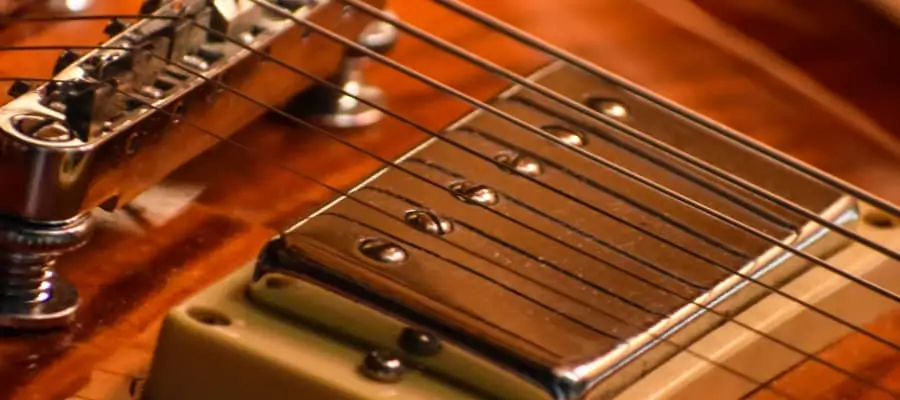
One of the main ways to categorize pickups is output level categorization. There are low, medium, and high-output pickups which indicate the output levels of the pickups and their performance with high-gain tones. Until here, it is pretty self-explanatory, but things get complicated as most companies use different means for listing the specs.
For example, Seymour Duncan, one of the leading pickup brands, uses DC resistance measured in ohms when showing the output of the pickup spec. However, DiMarzio uses millivolts. Other companies go with inductance measured in Henries, and some others use a combination of these three.
The DC resistance is the easiest and most common form as it is the easiest spec to measure. With a multimeter set to measure 20k ohms and a connection between the meter’s red probe and the pickup’s hot wire and a connection between the ground and meter’s black probe, you can immdeaditly see the DC resistance.
The DC resistance of standard pickups of Strats and Teles is usually between 8k and 6k ohms. Some lipstick tube single coils measure around 3k to 4k ohms, and some vintage PAF-style humbuckers measure around 8ö to 10k ohms.
Modern high-output humbuckers are around 12k ohms, while some even go over 20k ohms.
The more measure pickups have, the more they are suitable for hi-gain sounds. They will not lose their definition and clarity. The low output ones will, and in the higher gain setting, they can become muddy and undefined. This goes other ways too, so there is why there are so many variants of pickups on the market.
It would be hard to imagine listening to the Beatles play 20k active humbucker in their music. In the old days, there weren’t any. As music evolved and more bands played with more gain sounds, so were the pickups. Today it would be a joke to play modern metal music with vintage 4k lipstick single-coil pickups from the 50s. In theory, you could. But then again, in theory, you could drive Formula 1 circuit with a Fiat 600 from the 60s. All is possible but not recommended.
Can I Identify Pickups By Brand Or Model?
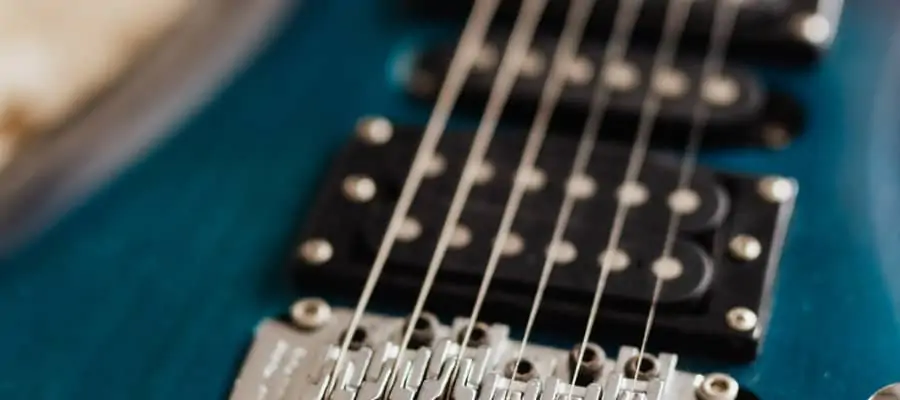
Now that we learned what kind of pickups can be in your guitar, whether active or passive, humbucker or single-coil, you can also find out from what brand they are or even the model.
Sometimes on the cover, there is a logo of the manufacturer, and by googling the brand and comparing the pickups, you find on the internet the model. If you are sure that the pickups in your guitar are original, go to the manufacturer’s website and find out what stock pickups they put in your guitar model.
But it’s not that simple with the ones that don’t have any labels on the cover. You can remove the pickup and look to the back of it to find a model number or a brand name, or even a serial number in some cases.
You’ll do it like this. First, remove the strings on your guitar. Then remove the pickup screws, and by doing that, you’ll be able to take the pickup and flip it to see markings underneath. Take your patience, and be careful not to damage the wires. Then if your pickup has a brand and model, that’s it; you know what it is. If it has only a serial number or some markings you’re not familiar with, try to search them on the internet and forums. You’ll probably find it there.
What Kind Of Single-Coil Pickups Are There?

As we learned, pickups can be passive or active. Single-coil that are active are very rear. So will focus here on what kind of passive ones are on the market. They can differ in various things.
- Type of Magnet- Alnico or ceramic magnet
- Multimeter Reads-High, Low or Medium output
- Isolation Type- Formvar, Plain Enamel, or something else
- Polarity- Most pickups for the middle position are Reverse Polarity to the Neck and Middle
- Cover- Plastic or Metal, or sometimes wood
So you see, there are many things that go into making them, and everything that is different will make them sound a little different; even the position on the guitar is in question. Here are the most famous and most popular single-coils on the market;
- Fender Custom Shop Texas Special Strat Pickup
- Seymour Duncan SSL 1
- Lindy Fralin Vintage Hot
- DiMarzio Area 58
- Fender Tex Mex Tele pickups
- DiMarzio Injector
- Lollar Blonde Strat
- EMG SA Set of Single-coils
What Kind Of Humbucker Pickups Are There?
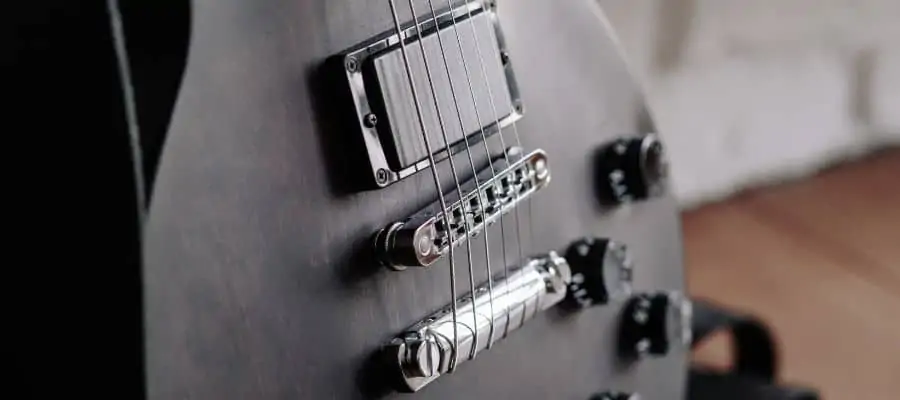
Humbuckers are actually doubled-up single-coil pickups that feature extra precautions to prevent external sounds. In other words, they are single-coils mounted side by side, with the reversed polarity of one of the magnets and the coils connected in series wiring. Like with single-coils is the case, same as with a humbucker, they can be different in lots of things;
- Active or Passive
- Type of Magnet- Alnico or ceramic magnet
- Multimeter Reads-High, Low or Medium output
- Cover- Metal, Plastic, or Uncovered
- Size- Regular or Single-coil format
- String count- they can be for 6, 7, or 8 string guitars
Again there are some things that are not so important in the way that they will sound, and some are the key to their sound, especially active or passive differences. It’s always good to know what sound you’re looking for. If you want Led Zeppelin classic rock, you’ll go for passive, medium output with metal covers. If you want Metallica modern metal sounds, you’ll probably want active ones with plastic covers and high output. Here are some of the best humbuckers on the market today;
- Suhr Doug Aldrich Humbucker
- Bare Knuckle The Juggernaut Humbucker
- Gibson Burstbucker Type 2
- Bare Knuckle Black Hawk Humbucker
- DiMarzio Super Distortion T
- Fishman Fluence Modern Humbucker
- Gibson ’57 Classic Plus
- Seymour Duncan SH-2 Jazz
- Seymour Duncan ’59 Neck
- EMG-81 Humbucking Active Guitar
- Tom Anderson Humbucker Set H1 and H2
How To Identify The Pickups By The Type Of Guitar?
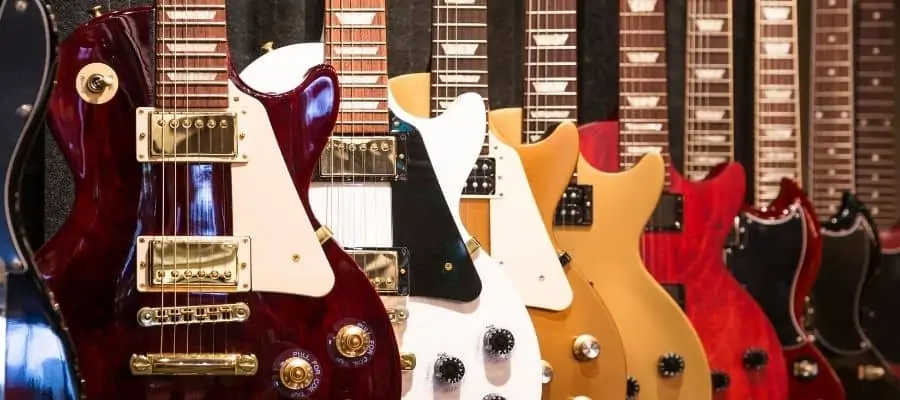
This will not apply in all cases, but in most will. Just by knowing the model of the guitar, you can tell what pickups are in it. Here are some of the most common models on the market. Some have only one pickup, most have two, and others have three pickups. As I said, nowadays, there are many guitar models with all kinds of pickup combinations, especially aftermarket stuff, but in general, this will apply.
| Guitar Model | Neck Pickup | Middle Pickup | Bridge Pickup |
|---|---|---|---|
| Gibson Les Paul Standard | Humbucker | X | Humbucker |
| Fender Stratocaster | Single-Coil | Single-Coil | Single-Coil |
| Gibson SG | Humbucker | X | Humbucker |
| Fender Telecaster | Single-Coil | X | Single-Coil |
| Gibson Les Paul Special | P90 | X | P90 |
| PRS Custom 24 | Humbucker | X | Humbucker |
| Ibanez SA460MBW | Single-Coil | Single-Coil | Humbucker |
| PRS Silver Sky | Single-Coil | Single-Coil | Single-Coil |
| Ibanez RG450DXB | Humbucker | Single-Coil | Humbucker |
| Jackson Kelly Js32 | Humbucker | X | Humbucker |
| Schecter Nick Johnston HSS | Single-Coil | Single-Coil | Humbucker |
| Schecter C-1 Hellraiser FR | Humbucker | X | Humbucker |
| ESP MH-1000 | Humbucker | X | Humbucker |
| Music Man Silhouette | Humbucker | Single-Coil | Humbucker |
| Kiesel Frank Gambale 1 | Humbucker | X | Humbucker |
| Yamaha Pacifica 1611MS | Humbucker | X | Single-Coil |
| Yamaha Pacifica 311H | P90 | X | Humbucker |
| Music Man The Majesty | Humbucker | X | Humbucker |
Conclusion
It’s always great to know what pickups are in your guitar. For example are they passive, with a low output, or are they active with a high output? Because if you don’t like the sound of them, if they are too thin and bright sounding for you, you’ll know what to look for to replace them. You’ll find some that will be darker and punchier in sound.
Today there is a vast variety of pickups offered by the companies in their production models. And even more aftermarket pickups from different companies specialized in only pickup making. So if you like your guitar, the way it plays and looks, but don’t like the sound, it’s always good to know you can replace them. And knowing what pickups are currently in, is a great thing. So later you can look for different ones, that will suit your need better.
If you found this article useful, you may want to save this pin below to your Guitar board.

Recent Posts
Some guitarists insist on buying an expensive amplifier with their electric guitar. They assume that this is a must for every type of guitarist out there. However, in some situations, this isn’t...
Top 50 Free Realistic Guitar VST Plugins With Sound Examples
As technology has rapidly advanced in the recent decade, computers are stealing more and more roles from physical musical instruments and accessories. Nowadays, you do not need expensive amps,...

